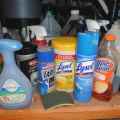Indoor Air Quality - Volatile Organic Compounds (VOCs)
People spend most of their time indoors - at home, school and work. This makes the quality of the indoor air you breathe important. We will focus now on certain kinds of chemicals called volatile organic compounds or VOCs that are found in many products that we commonly use. It is designed to help you think about what VOCs may be present in your indoor air and steps you can take to reduce them.






What are VOCs?
VOCs are chemicals that easily enter the air as gases from some solids or liquids. They are ingredients in many commonly used products and are in the air of just about every indoor setting. The table below shows some examples of products that contain VOCs.
How do VOCs get into indoor air?
Products containing VOCs can release these chemicals when they are used and when they are stored. Many times you'll notice an odor when using these products. Product labels often list VOC ingredients and recommend that they should be used in well ventilated areas. Ventilation means bringing in fresh, outdoor air to mix with indoor air.
Building materials and furnishings, such as new carpets or furniture, slowly release VOCs over time. It may be necessary to ventilate areas with new carpeting or furniture for longer time periods because VOC levels can build up again after the windows are closed. If possible, unroll new carpets or store furniture outside your home (in a shed or detached garage) to minimize odors before bringing them in the home. If that's not possible, open windows, close doors and try to stay out of rooms until odors are reduced.
If VOC containing products are used outdoors near your home, you may want to close windows and nearby vents to prevent chemicals from coming inside.
When you use a product containing VOCs indoors, the levels of these chemicals in the air increase, then decrease over time after you stop using them. The amount of time the chemical stays in the air depends on how quickly fresh air enters the room and the amount of the chemical used. Levels of VOCs will decrease faster if you open windows or doors, or use exhaust fans.
VOCs can also get into indoor air from contaminated soils and groundwater under buildings. The chemicals enter buildings through cracks and openings in basements or slabs. When nearby soil or groundwater is contaminated, you might be asked for permission to investigate indoor air at your property.
Products used at home or work can release VOCs into the air when used and stored.
| Examples of Household Products | Possible VOC Ingredients |
|---|---|
| Fuel containers or devices using gasoline, kerosene, fuel oil and products with petroleum distillates: paint thinner, oil-based stains and paint, aerosol or liquid insect pest products, mineral spirits, furniture polishes | BTEX (benzene, toluene, ethylbenzene, xylene), hexane, cyclohexane, 1,2,4-trimethylbenzene |
| Personal care products: nail polish, nail polish remover, colognes, perfumes, rubbing alcohol, hair spray | Acetone, ethyl alcohol, isopropyl alcohol, methacrylates (methyl or ethyl), ethyl acetate |
| Dry cleaned clothes, spot removers, fabric/ leather cleaners | Tetrachloroethene (perchloroethene (PERC), trichloroethene (TCE)) |
| Citrus (orange) oil or pine oil cleaners, solvents and some odor masking products | d-limonene (citrus odor), a-pinene (pine odor), isoprene |
| PVC cement and primer, various adhesives, contact cement, model cement | Tetrahydrofuran, cyclohexane, methyl ethyl ketone (MEK), toluene, acetone, hexane, 1,1,1-trichloroethane, methyl-iso-butyl ketone (MIBK) |
| Paint stripper, adhesive (glue) removers | Methylene chloride, toluene, older products may contain carbon tetrachloride |
| Degreasers, aerosol penetrating oils, brake cleaner, carburetor cleaner, commercial solvents, electronics cleaners, spray lubricants | Methylene chloride, PERC, TCE, toluene, xylenes, methyl ethyl ketone, 1,1,1-trichloroethane |
| Moth balls, moth flakes, deodorizers, air fresheners | 1,4-dichlorobenzene, naphthalene |
| Refrigerant from air conditioners, freezers, refrigerators, dehumidifiers | Freons (trichlorofluoromethane, dichlorodifluoromethane) |
| Aerosol spray products for some paints, cosmetics, automotive products, leather treatments, pesticides | Heptane, butane, pentane |
| Upholstered furniture, carpets, plywood, pressed wood products | Formaldehyde |
Should I be surprised if VOCs are in the air I breathe?
No. Because they are commonly used, some VOCs are almost always found in indoor air. The New York State Department of Health (DOH) and other agencies have studied typical levels of VOCs that may be present in indoor and outdoor air. Sometimes these levels are called "background levels".
The term "background levels" can be confusing because they can vary depending on where an air sample was collected and whether VOCs were used or stored. For example, a study of VOCs in urban areas might find higher levels than another study in rural areas. Some studies look at office environments, others examine residences. Please keep in mind study findings may or may not make sense for your setting.
How can VOCs affect human health?
Chemicals can enter the body through three major pathways (breathing, touching or swallowing). This is referred to as exposure. No matter how dangerous a substance or activity is, it cannot harm you without exposure.
Whether or not a person will have health effects after breathing in VOCs depends on:
- The toxicity of the chemical (the amount of harm that can be caused by contact with the chemical).
- How much of the chemical is in the air.
- How long and how often the air is breathed.
Differences in age, health condition, gender and exposure to other chemicals also can affect whether or not a person will have health effects.
Short-term exposure to high levels of some VOCs can cause headaches, dizziness, light-headiness, drowsiness, nausea, and eye and respiratory irritation. These effects usually go away after the exposure stops. In laboratory animals, long-term exposure to high levels of some VOCs has caused cancer and affected the liver, kidney and nervous system. In general, we recommend minimizing exposure to chemicals, if possible.
How can I reduce the levels of VOCs indoors?
- Find out if products used or stored in your home contain VOCs. Information about the chemicals in many household products are listed on the National Institute of Health's website.
- If you must store products containing VOCs, do so in tightly sealed, original containers in a secure and well ventilated area. If possible store products in places where people do not spend much time, such as a garage or outdoor shed. Better yet, buy these products in amounts that are used quickly.
- Dispose of unneeded products containing VOCs. Many of these products are considered household hazardous wastes and should be disposed of at special facilities or during special household hazardous waste collection programs in your area. For more information about disposing of these products, contact your city .
- Use products containing VOCs in well-ventilated areas or outdoors. Open windows and doors or use an exhaust fan to increase ventilation. Repeated or prolonged ventilation may be necessary for reducing levels from building materials (new carpeting or furniture) that release VOCs slowly over time.
- Carefully read labels and follow directions for use.
Interesting Links
Berkeley Lab - Information on VOCs
National Institute of Health - VOCs page.
